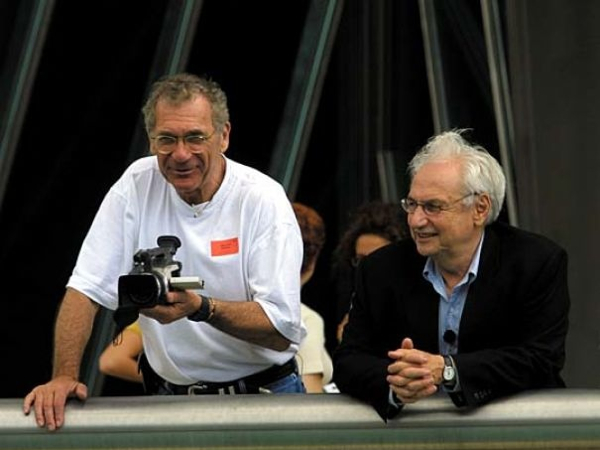Movie review by Greg Carlson
In “Sketches of Frank Gehry,” director Sidney Pollack (making his first documentary feature, which will be shown as an episode of the PBS series “American Masters”) explains his connection to the monumental architect: both men work in fields driven explicitly by the commercial demands of the marketplace, but both men think of themselves primarily as artists. The tension between these poles means that frustration and compromise occasionally trump the flights of self-indulgent fancy that would otherwise render their final products impossible. Like the doodles Gehry scribbles out on paper to chart the beginning of each of his projects, Pollack’s movie is a fairly easygoing introduction to Gehry that places admiration above anything else.
The “anything else” that does briefly make it into the movie is manifested in the form of professor and critic Hal Foster, the only major Gehry detractor given screen time. Foster makes several thought-provoking claims, but for each one Pollack is ready with praise from the likes of Dennis Hopper (who lives in a Gehry-designed house), Ed Ruscha, or Michael Eisner. Eisner, along with fellow power-brokers Michael Ovitz and Barry Diller, remind viewers of Gehry’s connection to show-business types, an arguably lowbrow element of his work that might dismay the scoffers and the snobs. If Pollack makes any major missteps, it is in the rather high pretentiousness quotient of the giant egos paraded from start to finish.
Gehry himself addresses the ego issue, but spends a great deal more time coyly cultivating the “aw shucks” self-effacement of a more humble man than the one capable of designing structures like the Walt Disney Concert Hall and the Vitra Furniture Museum. A meaty appearance by Milton Wexler, Gehry’s therapist for more than three decades, nimbly accounts for a slightly more accurate take on the monumental confidence and ambition of the movie’s titular subject.
Arguably best known for the spectacular Bilbao Guggenheim, Gehry’s magnificent post-1989 work reminds one of whimsical multi-paneled spaceships. The fluid alien landscapes of his buildings’ exoskeletons reflect light in shimmering, cascading waves, making the metallic plating appear to move as if it were alive. The legendary, late Philip Johnson nicely describes the importance of this component of Gehry’s style in one of the movie’s better interviews. Pollack also devotes a significant portion of the movie to explaining how computer programs allowed Gehry, with the support of his team of collaborators, to achieve previously unheard of options,
Pollack chooses to insert himself into the movie’s proceedings, following Gehry with a digital video camera. Their interactions give the movie a casual, conversational tone that beats the majority of the pompous talking heads (among them an over-the-top Julian Schnabel, sipping sprits in shades and a bath robe) that the director intersperses with his own one-on-one time with Gehry. Despite the movie’s mostly gritty, grainy look, the many images of Gehry’s buildings – inside and out – offer viewers a glimpse of the master’s breathtaking uses of space and materials. Whether one is an architecture enthusiast or is merely interested in seeing how a creative mind ticks, “Sketches of Frank Gehry” is well worth the effort.
